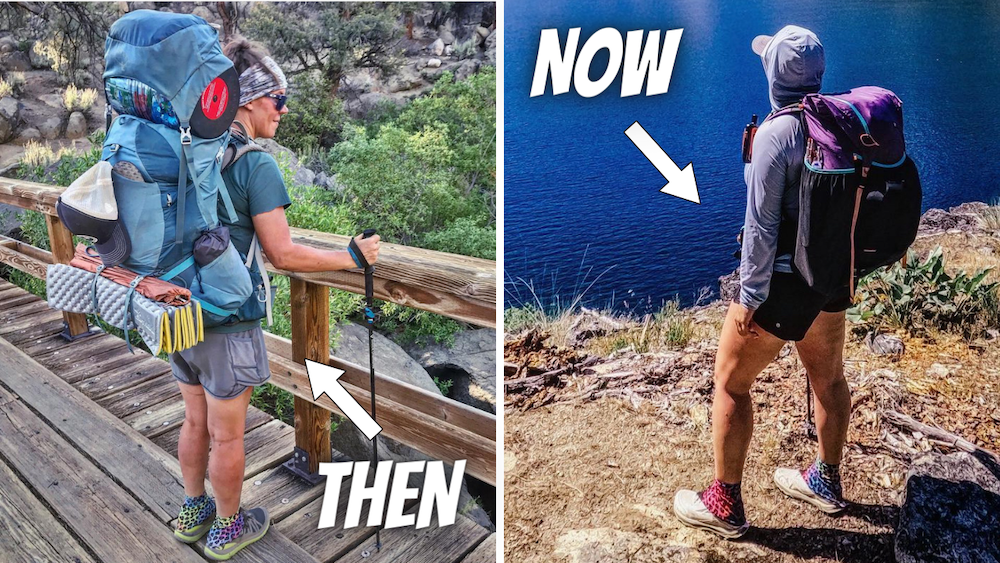
New to backpacking? Looking for a few good backpacking tips to help you get started? If you’ve watched any of my backpacking videos over the last few years, it might look like I’ve always had this “backpacking” thing figured out.
As an avid Northwest day hiker, solo long-distance backpacker, backpacking coach for women and The Hungry Hiker on YouTube, I’ve spent the last 6+ years going on and planning a ton of overnight backpacking trips. Everything from solo backpacking along the Pacific Crest Trail to backpacking around Mount Rainier on the Wonderland Trail, hiking the John Muir Trail and several group overnight backpacking trips with students in my online backpacking program for women, The Confident Solo Female Backpacker System.
Spoiler Alert: I’ve made a TON of mistakes along my backpacking journey, many of these lessons I’ve had to learn the hard way and have even documented here on my blog and on YouTube in some of my videos.
My backpacking journey is always a work in progress, but with each trip I go on, backpacking just keeps getting better and more fun.
If I was a beginner backpacker today, THIS is what I would do differently.
10 Backpacking Tips for Beginner Backpackers
Backpacking Tip #1: Use A Smaller Pack
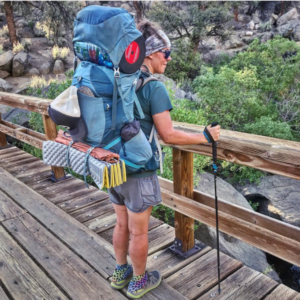 Something I wish I would have done when I first started backpacking was use a smaller pack.
Something I wish I would have done when I first started backpacking was use a smaller pack.
The first pack I ever bought was 80 liters. 80 LITERS!! I think my rationale was the bigger pack I had, the more room I’d have for all of the stuff I wanted to bring.
What I found though was the bigger pack I had, the more room I had to fill with stuff, which meant filling all of that extra space with stuff I didn’t really need for my trip. The more stuff I brought meant the heavier my pack would be.
I literally remember crying a little more than a mile into one of my first backpacking trips because my pack was so damn heavy.
Using a smaller pack forces you to be mindful with what you pack for your trip and reduces your chances of bringing all of that extra “what if” stuff you probably don’t need.
If you need help trying to decide what gear and clothing to pack for your next overnight backpacking trip, make sure you download my FREE Backpacking Gear Packing List.
Backpacking Tip #2: Pack Less Clothes
Something else I wish I would’ve done differently as a beginner backpacker was pack less clothes. EVERY beginner backpacker always packs way too many clothes for their first few trips.
When I first started backpacking, I would pack a new hiking outfit for each day I’d be out on trail along with a set of clothes to sleep in. I guess I thought if I had a clean set of clothes to hike in each day, I wouldn’t feel as dirty.
Along my first PCT thru-hike, one of the first things I sent home to myself were all of the extra hiking clothes I had packed.
Clothes are heavy and bulky and you’re going to get dirty while you’re out on trail. The sooner you learn how to embrace the dirt and stink and get used to hiking in one outfit for your trip, the lighter your pack will be.
When packing clothes for an overnight backpacking trip, plan on only bringing one outfit to hike in, which will be what you’re wearing and a set of clean clothes to sleep in.
I also always pack an extra pair of socks and underwear. Depending on the weather forecast and the area you plan on hiking in, you might want to consider packing rain gear and an insulating layer like a puffy jacket to wear while you’re at camp.
BUT you don’t need multiple outfits to hike in each day. I promise.
Backpacking Tip #3: Practice Packing & Unpacking My Pack
As a beginner backpacker, I wish I would’ve taken the time to learn how to pack my pack efficiently and practiced packing and unpacking my pack multiple times before heading out on trail.
When I first started backpacking, I would always wait until the night before or the morning of leaving for a trip before I’d pack my pack. Not a good practice.
That always led to a lot of unnecessary shoving and stuffing. None of my gear ever really had its place within my pack. Then if I needed to get something out of my pack when I was out on trail, it would usually be all the way at the bottom, causing me to have to take everything out of my pack.
I also felt like I was constantly losing gear because I could never remember which pocket I had stuffed that piece of gear in when I originally packed my pack.
Then when I’d go to pack up camp, nothing ever seemed to fit into my pack the way it had at the beginning of the trip.
Over the years, I have packed and unpacked my pack 100’s, maybe even 1,000s of times. This constant repetition of packing and unpacking my pack has led me to have a specific order in how I pack the gear in my pack. And since each piece of gear in my pack has a specific place of where it lives in my pack, I’m less likely to lose or misplace any of my gear.
When you become more efficient with packing and unpacking your pack, you’ll spend less time setting up and taking down camp, which can be a really nice skill to have when you’re dealing with bad weather.
Another bonus for being efficient with packing your pack is that you’ll no longer be the one person everyone in group has to wait on either at the trailhead or in the morning before getting out on trail for the day.
Backpacking Tip #4: Don’t Listen To People Who Tell Me I Shouldn’t Go Backpacking Alone
Something else I would have done differently as a beginner backpacker is not listen to the people who told me I shouldn’t go backpacking alone.
When I decided that I was going to thru-hike the Pacific Crest Trail back in 2018, I knew that I would have to hike the PCT alone because none of my friends or family wanted to do it with me. So I started telling people that I was planning this big, solo backpacking adventure and I was REALLY excited about it.
If you want to learn what someone is afraid of, tell them that you plan on going backpacking by yourself in the woods for 5 months.
A lot of people questioned why I would even consider going backpacking alone. They asked if I planned on bringing a gun. They told me they didn’t think it was safe, especially being out there by myself as a woman.
I let other people’s doubt and fears start to second guess my own decision to want to go hike the PCT by myself. I even tried talking myself out of going MULTIPLE TIMES. Taking on other people’s doubts and fears while dealing with my own fear of having to sleep outside in my tent by myself was probably one of the hardest parts of my entire PCT trip planning process.
Then I realized that the only thing worse than letting my fears and other people’s fears of me backpacking alone was if I didn’t go hike the PCT at all. I would always wonder, “What If?”
If backpacking is important to you and you’re tired of waiting for someone else to go with you or you’re tired of getting cancelled on, then plan a solo backpacking trip and go by yourself.
Hiking the PCT solo ended up being one of the best decisions I’ve ever made. It ruined my life in the best way possible. Since my first thru-hike, I’ve gone out on multiple backpacking trips for 100’s, even 1,000s of miles, most of them solo.
If I had listened to all of those people who told me I shouldn’t go backpacking alone, I would’ve never discovered the incredible confidence booster solo backpacking can be. My only regret is that I didn’t try solo backpacking sooner.
This is why I created The Confident Solo Female Backpacker System.
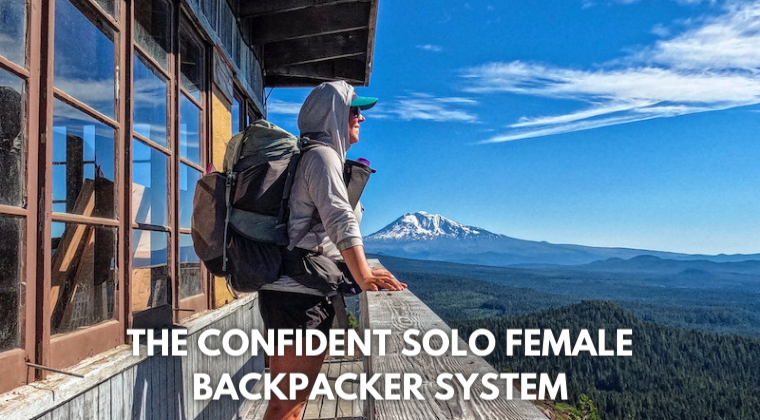
The Confident Solo Female Backpacker System is a comprehensive, self-paced, online backpacking program for women, designed to help you go from feeling scared and intimidated about backpacking to feeling comfortable with planning your own trips out in the backcountry.
Whether you’re a beginner or well-seasoned female backpacker, this program will walk you through, step-by-step, everything you need to know in order to plan, prepare and build up your confidence to comfortably go out for either your first or next backpacking trip.
I’ve taken everything I wish I’d known when I first started backpacking along with my own experiences of backpacking out on trail for 100s and 1,000s of miles and created the program I wish I had access to when I first started backpacking.
In addition to the online, self-paced program, students have lifetime access to live, weekly group coaching calls and a private online community made up of other likeminded female hikers and backpackers to help support, inspire, create accountability as they go through the program together and meet friends to plan future trips with.
Students of The Confident Solo Female Backpacker System also have the opportunity to join me for various group day hikes and overnight backpacking trips throughout the year.
Ready to turn your backpacking goals into a reality this year? If you’re serious about crushing your backpacking goals this year, CLICK HERE to schedule a one-on-one Zoom call with me where we’ll talk about your backpacking goals. If you’re a good fit for the program, you’ll have the opportunity to enroll into The Confident Solo Female Backpacker System during our call.
Don’t let someone else’s fears hold you back from wanting to achieve your backpacking dreams.
Backpacking Tip #5: Get A Satellite Messenger
As a beginner backpacker, the one piece of gear I wish I would’ve gotten sooner is a satellite messenger. Not only for my own peace of mind, but also peace of mind for my friends and family at home, especially with all of the solo backpacking I’ve done over the years.
The reason why I didn’t get a satellite messenger when I first started backpacking was because of how expensive the devices are. Plus, not only do you have to invest in the actual device, but they also require a monthly subscription for them to work. AND you have to invest the time into learning how to use the device and all of its features both on the device itself and through its pairing app before taking it out on trail with you.
There have been many times when having two-way communication through my satellite messenger has saved my butt out on trail. It’s been a valuable navigation tool whenever I’ve gotten turned around and lost while out on trail.
I’ve been able to reach out to family and friends while I’m out on trail without any cell or WiFi service to let them know whenever I’m running behind, so they don’t worry and call Search and Rescue to come find me, have them help me get a hotel reservation in the next town so I can sit out a heavy rainstorm and even coordinate rides back into town from the trailhead.
If you’re on a group trip and multiple people in your group have a satellite messenger, you have the ability to communicate with one another if you get separated and are out of cell and WiFi service. No more second-guessing which way they went or having to leave messages on trail using sticks and rocks.
And, god forbid, if I ever had to press the SOS button in an emergency, I have two-way messaging with first responders so I can let them know the state of my emergency so they can send me the help I’d need to my exact location.
Yes, a satellite messenger can be a very expensive piece of gear, but for me, it’s really hard to put a price tag on peace of mind when I’m out in the backcountry by myself.
Backpacking Tip #6: Do My Research And Work On My Navigation Skills (Sooner)
As a beginner backpacker, something I wish I would’ve done differently is made it a priority to do my own trail and trip research AND learn how to be more confident with my navigation skills sooner.
By learning how to do my own trail and trip planning research, I’ve been able to become less dependent on other people when it comes to trip planning. I can now plan the trips I want to go on, for the destinations I want to go to, whenever I want to go.
By learning how to become more confident with my navigation skills, I’ve been able to reduce my fears of getting lost whenever I’m out on trail. I’m able to feel more confident with staying found while I’m out there and feel more comfortable going beyond trails I’m familiar with, leading me to want to explore new-to-me areas.
To start building up your own confidence with your navigation skills, I highly recommend taking a basic navigation course, whether it’s in-person or online. Learn how to read a paper map and use a compass. Learn how to use one of the many digital navigation apps like onX Backcountry, Gaia GPS or the FarOut Guide app.
What’s nice about these digital navigation apps is that not only can you use them for on-trail navigation, but they’re also valuable trip planning tools you can use to plan your trip before getting out on trail.
Get 20% off your purchase of onX Backcountry OR start a free 14 day trial of onX Backcountry Elite by CLICKING HERE and using promo code “HungryHiker”.
No matter which navigation tool or trip planning resource you use, whether it’s onX Backcountry, Gaia GPS or the FarOut Guide app, pick one, learn how to use it and practice using it before you get out on trail.
Backpacking Tip #7: Don’t Buy Gear Just Because I Saw It on YouTube
Something else I would’ve known as a beginner backpacker is to NOT buy gear just because I saw someone else using it on YouTube.
I know. Coming from someone who often creates YouTube videos talking about the gear I love (and even not love) using out on trail, this tip might sound a little weird, but hear me out.
Instead of running out and buying a piece of gear you saw on YouTube, take the time to figure out if this is piece of gear you really NEED and is actually going to work for you and the backpacking trips you want to go on.
Backpacking gear can be so personal. We all have different needs and wants with the gear we choose to use out on trail. Backpacking gear is not one-size-fits-all.
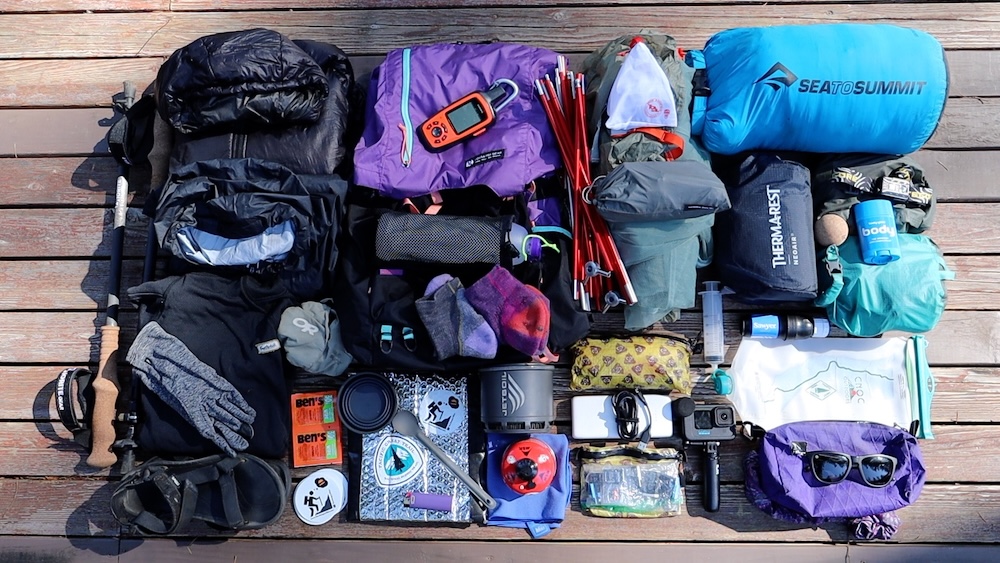
Instead of rushing out to buy a piece of gear just because you saw someone on YouTube rant and rave about how much they love it, take the time to figure out what features are important to you and the types of trips you’d be using the piece of gear for. Then see if you can try it, borrow it or rent it before investing in it.
Backpacking Tip #8: Learn How To Meal Plan
Something I used to do when I first started backpacking was throw a bunch of random backpacking meals and snacks into my food bag for a trip and call it good.
I was always so worried about the gear I brought and making sure it all fit into my pack that backpacking food and snacks were a mere afterthought.
I never took into consideration putting together a meal plan for my trips and I never had any idea how many calories I was eating or needed to eat each day while I was out on trail. It only took a few trips of being hungry and even bonking during the trips before I realized that I needed to start paying more attention to the food I was packing.
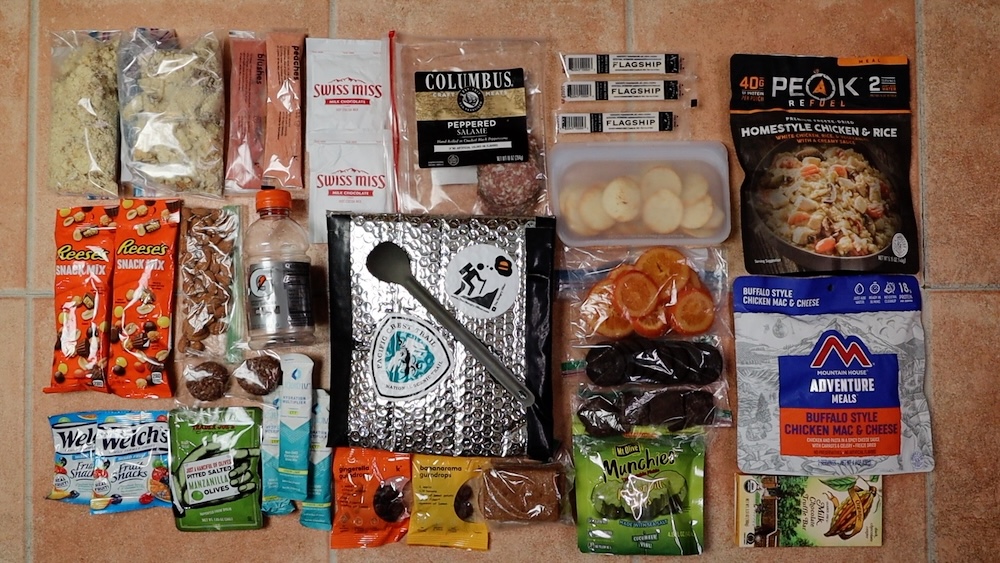
Take the time to learn how to put together a backpacking meal plan for each of your trips. Often times, I would keep packing the same food over and over again and would eventually get food fatigue.
Expand your on-trail menu by learning how to dehydrate or freeze-dry some of your favorite home-cooked meals and make them trail-friendly. By learning how to prepare your own backpacking food, you can make healthier options that are less expensive than the freeze-dried meals you can buy at outdoor retailers.
As The Hungry Hiker on YouTube, I’ve put together a few videos showing you how I turn some of my favorite home cooked meals into dehydrated backpacking meals. If dehydrating your own food isn’t your thing or something you’re interested in, one of my favorite backpacking meal planning resources is The Backcountry Foodie.
Backcountry Foodie is an online meal planning service for backpackers, created by a backpacking, registered dietician nutritionist that specializes in simple, ultralight backpacking meal options, which are designed to help save backpackers time, money and weight.
If you’re interested in learning more about how The Backcountry Foodie can help you put together a backpacking meal plan for your next trip, CLICK HERE and use coupon code “HUNGRYHIKER20” to get 20% off your membership.
Backpacking Tip #9: Carry Less Water
One of my biggest fears when I first started backpacking was running out of water. They say you always pack your fears, which for me, meant carrying a whole lot of water weight.
As a beginner backpacker, I used a 3-liter hydration reservoir to store all of my water in while I was out on trail. I liked the ease of using a drinking tube with my hydration reservoir because I felt like I drank more water this way, but when the reservoir was full, it would make it hard to pack my gear into my pack.
Some other problems with carrying this much water in the reservoir:
Often times, I would be carrying so much water that I’d reach a water source and still have more than enough water to make it to the next few water sources.
I could never tell how much water I had left in my reservoir because it would be buried deep into my pack, covered with all of my gear. This led to me running out of water a few times during my trips.
Whenever I needed to filter water and refill my reservoir, I’d have to take EVERYTHING out of my pack just to get to the reservoir. This is how I quickly became very efficient with learning how to pack and unpack my pack because I had to do it so much while out on trail using a reservoir.
Also, if for some reason the reservoir wasn’t closed correctly or all the way or if it got punctured, I risked getting all of the gear in my pack soaked from the water in my reservoir.
It took me a couple of years, but I finally made the switch from using a 3-liter hydration reservoir and always carrying way more water than I needed, to using only TWO 1-liter water bottles to filter and store my water in along with an empty 2-liter dirty water bag.
I carry one 1-liter bottle of water on my pack shoulder strap so I have easy access to drinking water as I hike. I also have a visual on exactly how much water I have at all times.
Then I have another 1-liter water bottle in an outside pocket of my pack that I can use to drink from until I reach the next water source. Then at the water source, I camel up on water by drinking a liter of water and then filling up both water bottles before I start hiking again.
With this system, I do have to stop to filter water more often, but I don’t carry nearly as much water weight, which means I can hike faster to get to the next water source because I’m not bogged down with water weight.
Also, there’s no more guessing of how much water I have because I can always see how much water I have in each bottle without having to dig into the inside of my pack.
Being efficient with this type water storage system means knowing how to read a map and using a digital navigation system to see where and how far away the next water sources are on trail. Consider the water weight savings an inspiration for wanting to learn how to be more confident with your navigation skills and using your navigation tools when out on trail.
Backpacking Tip #10: Started My Backpacking Journey Sooner
And finally, as a beginner backpacker, the last tip I have for you that I wish I would’ve done differently was to have started my backpacking journey sooner.
I only really started getting into backpacking within the last ten years. Over these last few years, I’ve managed to hike a LOT of miles out in the backcountry and go on some incredible trips.
That’s only because I got tired of telling myself I wanted to try this backpacking thing ONE DAY and finally started making it a priority. Now, it’s all I want to do.
I’m always in the process of planning my next backpacking trip.
If you’re thinking about wanting to get into backpacking or are curious if backpacking is something you’d be into, stop talking about doing it some day. Instead, put it on the calendar, make a plan and go.
How are you going to know if you love or don’t love backpacking if you never take the time to plan your trip and do it?
I’ve created a number of videos on YouTube sharing some of my favorite trip planning tips and tricks for a lot of the backpacking trips I’ve planned over the last few years. Feel free to check out any of those videos to help you get inspired to want to start planning your next trip.
Remember, we all start out as a beginner backpacker at some point. Even now as an experienced backpacker, I’m still learning new things about backpacking with every trip I go on.
One of the awesome things about backpacking is that there’s NO ONE RIGHT WAY to do it. It doesn’t matter if you’re a beginner backpacker or if you’re a seasoned professional, there’s ALWAYS something new to learn about backpacking and there are different ways of doing it.
You never really know all there is to know about backpacking because with each trip you go on, you’re always learning from the last one how to make the next trip even better.
I hope by sharing with you some of the things I’d do differently as a beginner backpacker, you won’t have to make the same mistakes I did AND are now more inspired than ever to want to start planning your next overnight backpacking trip.
Disclaimer: The-Hungry-Hiker.com is a participant in the Amazon Affiliate Links and AvantlInks Program, affiliate advertising programs designed to provide a means for sites to earn advertising fees by advertising and linking to Amazon.com and other affiliated sites at no cost to you. Please note, I only link to products and services I personally use and trust.
